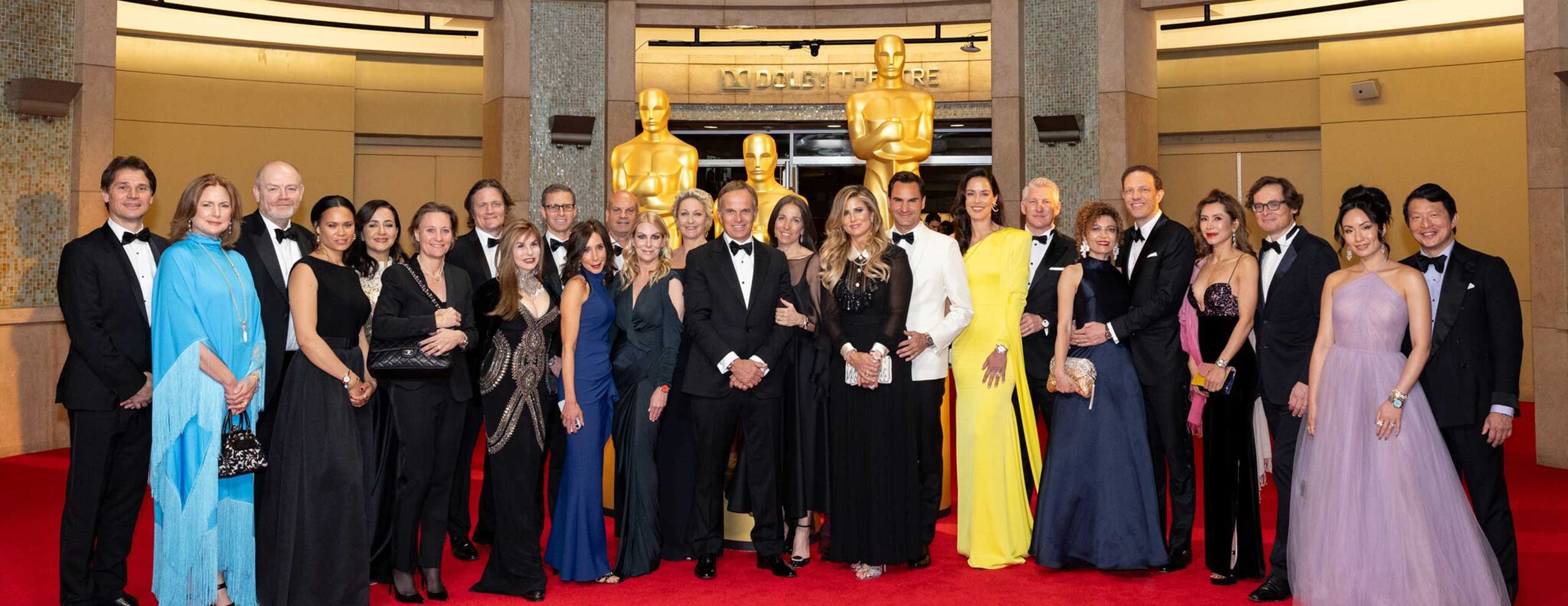Credits: Article and images by Wei Koh @ Revolution Watch Magazine. See the original article here - https://revolutionwatch.com/rolex-academy-awards/


The gift of the world’s best storytellers is their capacity to unveil to us seemingly universal truths that were once obscured by the miasmic clouds of our own limited perception. They are the truth givers, the light bringers, the providers of epiphany.
It was just this kind of universal truth that was revealed to me as James Cameron, the world’s most commercially successful Oscar-winning, game-changing, cinematic soothsayer nonpareil explained Rolex’s mission in the movies to me. From the moment I boarded my Air France flight from Geneva to Los Angeles, I had been turning over these questions in my mind.
What is the connection between the world’s greatest watch brand and the world of cinema? Why has Rolex been, since 2017, the Exclusive Watch of the Academy of Motion Pictures Arts and Sciences and Proud Sponsor of the Academy Awards?
Why did Rolex become one of the key patrons and Founding Supporter and Official Watch of the Academy Museum of Motion Pictures, which was inaugurated in 2021? Finally, why has Rolex selected as its Testimonees two of the greatest filmmakers in cinematic history — James Cameron, the unrivaled master of high-concept escapist movies, and Martin Scorsese, the greatest social realist director who has ever lived?
After all, when you say the name Rolex, to this day, it conjures up images of extraordinary courage in the pursuit of human conquest. You say “Rolex” and you think of Sir Edmund Hillary and Tenzing Norgay summiting Everest, or Chuck Yeager breaking the sound barrier, or Mercedes Gleitze swimming the English Channel, all while wearing Rolex watches.
So why is Rolex now focused on championing movies after being so inextricably associated with the greatest acts of human bravery in history? The answer was made clear at James Cameron’s Lightstorm Studio: It’s because if Rolex is truly the brand of exploration, if Rolex is truly fueled by the vast ceaseless compulsion for human conquest, then the greatest unexplored realm is that of the human imagination.
James Cameron made this abundantly clear to me when he explains, “Films are the journey of the heart and mind.” He should know as he has twice set the record for the highest grossing film of all time.
First with Titanic in 1997, which remained the box office heavyweight champ until he broke his own record with Avatar in 2009. His films are acknowledged by critics such as Roger Ebert to be “flawlessly crafted” and “spellbinding” storytelling of the highest order.
To me, Cameron is a director who is virtually prophetic in his capacity to see the future. Don’t forget that the plot of Terminator, which he created in 1984, where AI becomes the biggest threat to humanity, is exactly one of the most heated topics of today.
Rolex and the realm of human imagination
Since the Lumière Brothers held their first commercial screening at Paris’ Salon Indien du Grand Café in 1895, human beings have been inexplicably drawn to the movies. Perhaps it is because, to borrow from Sigmund Freud, in the world of cinema, the “id” or the primitive and unconscious part of the human mind is allowed to wander unrestrained and free.
We can see projected on the screens all the hopes, dreams, fears and desires buried within us made manifest through these visions of light. Cinema in the 20th century would take over from the oral and written storytelling traditions because moving images were far more universal as a language.
Cinema would inspire us with edifying tales of human perseverance like Frank Capra’s It’s a Wonderful Life (1946), have us collapse in supine heaps of laughter with comedic masterpieces like Howard Hawks’ Bringing Up Baby (1938), hold us in suspense with terse masterpieces like Orson Welles’ Touch of Evil (1958), and provide cautionary tales on the grandest scale with Welles’ incendiary Citizen Kane (1941).
It is only natural that with their inextricable link to adventure, exploration and performance under adversity, Rolex watches would be the watch brand most featured in films. Sean Connery donned a reference 6538 Submariner “Big Crown” on a NATO strap with his white tuxedo jacket in an act of incongruous sartorial brilliance as James Bond in Dr. No (1962).
The watch perfectly defined him as a man always on a mission regardless of his milieu. Marlon Brando wore his own GMT-Master with its bezel removed to help depict the deranged mental state of his character Colonel Kurtz in Apocalypse Now (1979).
Dustin Hoffman traded his Rolex GMT-Master II “Pepsi” with a taxi driver to escape Nazis in Marathon Man (1976). This watch which also appears in Sam Peckinpah’s Straw Dogs (1971) was Hoffman’s personal watch.
Who can forget Alec Baldwin’s character Blake brandishing his yellow gold Day-Date as a hyper aggressive embodiment of his net worth in Glengarry Glen Ross (1992) replete with the line, “You see this watch? That watch costs more than your car,” as he belittles Ed Harris’ Dave Moss.
Rolex, as I already knew, has always had a starring role in cinematic history. But, of course, that alone didn’t explain the brand’s relatively new association with the Academy Awards.
James Cameron’s relationship with Rolex
Instead of jumping to conclusions, I thought I should first listen to people I met on my L.A. trip. In particular, I’d never witnessed a watch brand with a more totally committed partner than James Cameron.
He explains, “I first learned about Rolex through diving. For me, any free time I have, I want to spend it underwater.
“When I was starting out, all the divers I knew aspired to or owned a Rolex. It was the ne plus ultra of diving watches.
“That was what attracted me to the brand and eventually I bought a Submariner. This was the watch I used on all of my dives.
“I wore it on every submersible exploration to the wreck of the Titanic. I wore it when I made the solo descent to the deepest point on the planet.
“It was also the watch I was wearing on stage when I won the Academy Awards [for Best Picture and Best Director, amongst others]. The idea of a watch that goes from underwater to black-tie on stage is pretty remarkable as well.”
Rolex’s relationship with the visionary director began back in 2011 while Cameron was preparing his submersible to descend to the deepest part of the deepest place on the planet, the Mariana Trench. For Arnaud Boetsch, Rolex’s director of communications, the synergy with Cameron and his mission has been incredible.
It was, after all, Rolex that partnered with Jacques Piccard and Don Walsh in 1960 to descend to the 35,814-feet depression at the bottom of the world in the Trieste bathyscaphe. Attached to the hull of the Trieste was an experimental Rolex prototype with a massive domed crystal named the Deep Sea Special.
The watch worked perfectly despite the incredible pressure it was subjected to. Walsh had also been the person advising the famous director in his bid to become the first person to solo dive aboard the Deepsea Challenger.
As it happened, three years earlier in 2008, Rolex had launched the Rolex Deepsea, a watch that set a new benchmark of 3,900 meters or 12,800 feet for deep submersion diving watches and featured Rolex’s Ringlock technology to withstand the pressure at depth. While this watch featured a steel case with a titanium caseback, Rolex rapidly created a full titanium Deepsea Challenge experimental divers’ watch to accompany Cameron outside the submersible on his mission.
Cameron recalls, “Once we agreed to work together, Rolex had about six weeks to make the watch that would have to be water resistant to an insane 11,000 meters or 36,090 feet … They worked around the clock on the watch and Rolex had to create new testing equipment just for it.
“But to their credit, they made it happen. A funny story is that we went through every safety check imaginable for the watch and when we first tested it, for some reason, it stopped.
“Then we realized we had forgotten to wind it!” Cameron laughs and continues, “By the time of the actual dive, we had dedicated two guys just to the task of keeping the watch rewound.”
On March 26, 2012, Cameron reached his objective in half the time that the Trieste, the last vessel to submerge to the same point, had taken to achieve this. During the dive, he was able to take samples that led to the identification of 68 new species of underwater life.
What began as a relationship to reach the deepest place on earth soon evolved into a truly mutually beneficent partnership. Says Cameron, “I’m a simple guy.
“I don’t live in Hollywood. I live in New Zealand.
“I would never seek to endorse any product. But there is an authenticity to Rolex that is unique.”
Cameron is right about Rolex’s uniqueness. Let’s look at why.
First, the company’s 10-billion-Swiss-franc turnover in 2023 is equivalent to the GDP of a country like Bhutan. On top of this 10 billion Swiss francs, the margin given to its retail partners is an estimated 5 billion Swiss francs, because Rolex has always believed in partnerships.
Says industry expert and the author of the Morgan Stanley Report on luxury watches, Oliver Müller, “This is in marked contrast with many other brands or groups. When times are good, they often try to cut out the retailers and go direct to clients to gain more profit.
“But Rolex is not interested in short-term gain. It is interested in perenniality, in relationships and partnerships that endure, and in this way it is incredibly loyal.”
One caveat is that last year Rolex purchased (what many believe is its own largest retailer) the Bucherer Group. Müller continues, “And this is especially impressive at a time when Rolex’s brand equity has never been higher and demand has never been stronger.”
Rolex does more business than all the rest of the Swiss watch industry put together. At the same time, almost every single Rolex watch has a secondary value higher than its primary price, which assures that demand will always outstrip supply.
If you are a Rolex retailer, you don’t need to sell Rolex watches; you simply choose who to assign them to. And if you are a Rolex retailer, more than half of the watches you sell are Rolexes.
Furthermore, Rolex attracts clients to you so that you are able to sell other brands. I often say that without Rolex, there would be no Swiss watch industry, and that is the truth as Rolex lays the foundation for the entire industry.
In reality, Rolex has become more than a watch brand. It has ascended to a category beyond all others.
It is unrivaled by any other luxury brand. Period. Go to any nation on the planet.
You might not speak the language or understand the culture, but if you say the name “Rolex,” everyone will understand what you mean. Rolex watches could be traded on a global exchange like the NASDAQ.
The point to all this is, Rolex doesn’t need to focus on selling more watches. Instead, and this comes to the rationale for its partnership with the Academy Awards, it is in the process of forging its inextricable bond with the advancement of human culture through the extraordinary art of cinema.
This connection with cinema and the Academy Awards happens even as Rolex’s brilliant leader Jean-Frédéric Dufour enacts another subtle but important evolution in the brand. It is shifting gears to ascend ever brilliantly upwards in the high luxury category.
Says Müller, “The brilliance is that a Rolex watch still retains all its core characteristics as the ultimate sports watch. From a performance perspective, with the widespread adoption of its own in-house escapement and hairsprings, Rolex is massively enhancing the underlying chronometric performance of its watches.
“It never forgets its roots as a ‘Superlative Chronometer.’ But as a brand, it has evolved toward higher and higher quality, with precious metal, gem-set watches, watches with enamel and stone dials becoming a more significant part of the offer.”
At 10 billion Swiss francs in turnover, based on 1.2 million watches, that means Rolex’s average price point is above 8,000 Swiss francs. You will find that this is significantly higher than just five years ago.
The watches themselves have stayed true to their roots but now are capable of expressing fun and whimsy as with the Day-Date “Jigsaw Puzzle” which features a stunning champlevé enamel dial in a puzzle motif, and replaces day and date functions with words and symbols representing emotions. This is an immeasurably important watch because it signifies Rolex’s departure from the pure pragmatism of its tool watch roots to embrace the generating of greater emotion with its status as a high luxury object.
Yet this is just part of the brilliant two-part strategy of Jean-Fred Dufour. Says Müller, “Because even as Rolex left its previous exclusive domain as the unrivaled king of the luxury tool watch, Dufour transformed Tudor to become the perfect replacement and had it take up position precisely in the space Rolex left behind.”
What was it like to be invited by Rolex to attend the Academy Awards? Two words, amazing and surreal.
First, we were accompanied by Rolex Testimonees and tennis stars Roger Federer and Ana Ivanović who are so approachable and friendly that I forgot Ivanović is a former World Number One and Federer is the greatest and most elegant player to ever pick up a racket. So much so that I ended up comparing Rolex Daytona “Le Mans” watches with Federer while fist bumping Ivanović for her incendiary white gold Rolex Daytona “Rainbow.”
It must also be said that her husband, the German football legend Bastian Schweinsteiger, is an incredibly cool and chill dude. But the point is, as we were all invited guests of Rolex, there was a wonderful sense of fun and camaraderie.
The day began with hair and makeup for my fiancée, Beatrice “Bebe” Ding. On her wrist was her Rolex Oyster Perpetual 36mm in blue, which I gave to her last year for her birthday.
It, of course, dawned on me that every single personal milestone in my life has been celebrated with a Rolex. Next, we joined the other guests by the hotel lake to take a group photo.
Never before had I felt more overwhelmed by the magnitude of the accomplishments of the other members of the group, in particular Dufour and Federer. Then we were whisked away in a convoy of black SUVs for the Kodak Theater.
Once we had passed through some preliminary security, I was amazed at how communal the experience was. Everyone from movie stars such as Bradley Cooper and Emma Stone to civilians like us walked the same red carpet.
By and large, everyone was affable, smiling and happy to make small talk, especially with the lines of fans and press that were arrayed on either side. Almost six years ago, a team from Rolex consisting of Arnaud Boetsch and Rolex USA president Luca Bernasconi first made their way to the Academy Awards and discovered something magical about this community — in particular that it really was a mutually supportive community and family, and that to be recognized with an Oscar truly is the ultimate dream and goal of any filmmaker or actor, because it is recognition by one’s esteemed peers.
Before coming to the Awards, out of respect for the process, I made an effort to watch every one of the films nominated in each category.
Twenty-five years ago, I worked as the assistant to a film director named Kathryn Bigelow. You’ve probably heard her name as she is something of a genius and was the very first woman to win the Best Director category with The Hurt Locker (2008).
In 1998, she was invited to the Venice Film Festival as a judge. That year, a film by Serbian filmmaker Emir Kusturica named Black Cat, White Cat ended up winning the Golden Lion award.
Kusturica’s absurdist vision of the world was so wildly original and immensely entertaining that I’ve never forgotten it. I felt the same way watching Yorgos Lanthimos’ Poor Things, a film so wildly and bizarrely original that it is unforgettable.
It is one of the most courageous and brilliant films I’ve seen in a long time and the perfect counterpoint to what sometimes feels like a contemporary cinematic lexicon that’s over inundated by superhero movies. I have to say I was really happy when Emma Stone won her Academy Award for her role in the film.
Moreover, I was amused by how emotionally invested I was in each and every award. By now you’ll know that Christopher Nola’s Oppenheimer won Best Picture as most people expected.
However, two smaller films The Holdovers and American Fiction remained my two favorites of the year along with Poor Things.
From the Dolby Theater, we made our way to the Governor’s Ball. From our vantage point at the table reserved for Rolex, we could see the winners getting their Oscars engraved.
I finally understood with total clarity that Rolex is now part of the Academy Awards and the larger cinematic universe. Just as it had evolved from being a pure sports watch brand, it is now evolving from its association with the exploration of our physical and natural world to become a champion for the exploration of the most uncharted realm of all — that of the human imagination.
And it has spared no effort to forge this link in the most meaningful, purposeful and authentic way that befits its title as the indisputable king of the Swiss watch industry.
Credits: Article and images by Wei Koh @ Revolution Watch Magazine. See the original article here - https://revolutionwatch.com/rolex-academy-awards/











